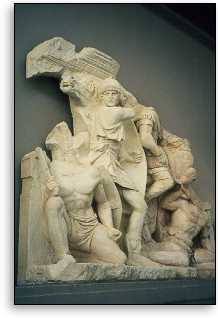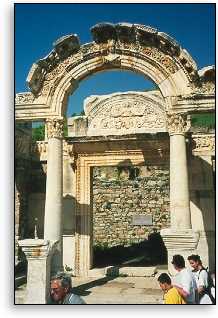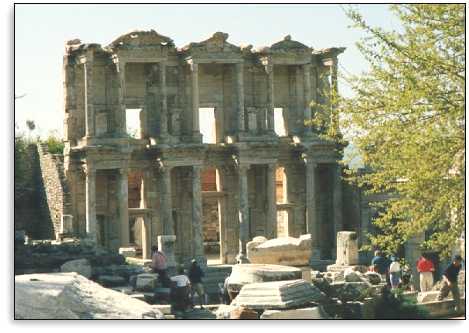Ephesus,
Virgin Mary's
House
Western Turkey - Personal Journal
Day
15 - Wednesday, 15 April 1998
The last full day of our tour began in Kusadasi as we went from our hotel to the ruins of the Isa Bey mosque, its open-to-the-sky interior littered with artifacts, wildflowers and weeds. The call of the muezzin was unusually long and spoken rather than just the singsong wail we usually hear. Afterward, Meli told us that he was announcing the death of a woman in the village.

Meli told us the history of Ephesus, known to some as Efes, which means bee. In this place was built a temple to the goddess, and the Efes town fathers sent word around to all, that whoever worshipped a mother goddess, no matter what name they knew her by, this was the same one. They called her Artemis, but a name was just a name. She was the Mother Goddess.
Anyone could worship their own version of the mother goddess here, in whatever way they were accustomed to worshipping her. And so they came, the people from all around, those who followed the silk road which ended here at the western coast of Asia Minor, and those who came to buy what had arrived from the far east by way of the silk road. They brought the symbols of their worship, and gave offerings to Artemis. The city fathers grew steadily more wealthy. Artemis' personality grew also.

Our next stop was the museum, and in the museum was a recovered statue of Artemis, as well as one of Diana. Meli made sure we noticed the difference between the two. The Greek Diana was a goddess of the hunt, a lithe figure with a bow and a stag. The Anatolian Artemis was more matronly, and was covered in symbols that had been brought by other goddess worshipers. Among the animals, birds, fruits and other emblems, there was the bee, the Efes. The most intriguing feature of this idol has always been the globes attached to the upper body. People have mistakenly thought they represented many breasts. Meli points out that in reality they are representative of the testicles of bulls or rams that had been sacrificed to Artemis.
After the museum, we had a brief shopping experience in some little shops nearby. A table was covered with small replicas of statues, with Virgin Mary and Artemis presented side by side for purchase.

Virgin Mary's House
After lunch, we made our way up the side of the mountain to the Virgin Mary house, believed to be the home of the mother of Jesus after his crucifixion. On the cross, Jesus had given her into the care of John, and the legend says that the two of them came here to live.
Significantly, there is no tomb for Mary, only the remains of a house that is dated from the first century A.D. Early Christian writings indicate that John lived here to old age, except for the period of time when he was exiled to Patmos, where he wrote the Book of Revelation.
Ephesus (Efes)
Our next stop was the partially excavated ruins of Ephesus, believed to have been a thriving city until the 3rd or 4th century. It was gradually and finally abandoned because of the malarial swamps formed by the silting up of the harbor. Touring the city of Ephesus, I had the strong feeling that we had come in through the "back door." The pile of used plumbing tiles, many partially blocked by minerals, was the first thing that caught my attention. They looked quite modern, and showed that the city had excellent plumbing, with running water that flowed down from storage tanks on the adjacent hillsides.

But Meli drew us on into the town, showing us the arches, the streets, the theater - Oh, the theatre! Only Meli could take us into a ruin such as this and verbally transform it into a place of light and color and sound, all beautiful to imagine. The beautiful marble of which it was constructed was still very much in evidence, but we needed our imagination and our memory of the stained glass she had shown us in the museum to now "see" the theatre in its original splendor. As she spun the pictures with her words, we could see men and women in their colorful togas and gold jewelry, sitting in the light that filtered through the stained glass windows near the top, secure from the weather underneath the covered dome while music played or dramas were reenacted. We could imagine them leaving the theatre, with a need to visit a WC - oh, how handy.
There is a public restroom nearby which seats 48. It too, is provided with live music, so as you sit cheek to cheek with your fellow man or woman, the sounds are covered. There are no partitions between potties here, just all one big happy family. This casual togetherness was not only in the public facility, Meli told us. The private homes had bathrooms with three seats together - no partition. There is a door at the entry, because then as today, you must pay to use the facilities. But no expense was spared to make this as beautiful as the rest of the city. The floors are covered with mosaics, the walls are faced with marble, a pool in the center of the room is surrounded with marble columns and in the pool are marble statues of Eros riding on dolphins.
On we went, down the wide street paved with marble, gazing in wonder at the mosaic sidewalk, staring at the columns and statues which line the streets in splendor. Our minds must fill in the missing covered colonnades that protected the strollers and shoppers from sun or rain. We must remember the beautiful statues we saw in the museum and think how they would have looked set in between the columns designed to showcase them. We can imagine the sun rising behind the white marble horses and soldiers, coloring the streets with golden light. We can imagine the water pouring from the mouths of the stone lions when it was needed to cool the street under the hot sun, or to wash away the dust and dirt.
We see on our right what remains of the monument to Trajan (98-117 AD), with its inscription "I conquered it all, it's under my foot." All that can now be seen of his statue is the foot and the round globe. Even then, apparently people understood that the world was round. This has also been confirmed in early Christian writings, with the earth being referred to as a sphere.

Before us stands the library, three stories high, built to honor Tiberius Celcus after he died in 114 AD. Cleverly engineered to seem wider than it is, and taller than it is, it gives the impression of reaching into the heavens. The elaborate facade shelters four female statues that represent the virtues; knowledge, friendship, understanding and wisdom.
Across from the library would have been the brothel, and we do get to see the public advertisement for it - in a square of the street leading into town there is a picture of a left foot, a woman and a bird, together with a number. The meaning is, on the left side of the street is a woman who will love you as sweetly as a bird for this price.
Not far from this stone advertisement is a standing stone carved with a soldier "doing battle" with a very healthy and undamaged feather (writing instrument). Someone wanted to say clearly, the pen is mightier than the sword.
Comparing our visit with Meli's book, I think we missed some things, perhaps because they are no longer open to the public, or because we simply didn't have enough time. How could we have had more time and gotten more from our visit to this ancient and important city? What if we'd skipped the jewelry shopping after the museum? How about leaving out the Mary house?
But the Mary house was significant in a strange sort of way, even for those of us who don't see Mary as deity. Here is a place where Catholics can worship in one room, while Muslims worship in the next, and around the bend is a provision for pagans to tie their prayer cloths to branches or to a lattice specifically installed for that purpose. Meli had done a good job of teaching us how the worship of the mother goddess was accumulated and consolidated into Artemis (called Diana in the KJV of the Bible) at the temple built to her in Ephesus. Today in the museum, in the Mary house, and in the uncovered ruins of Ephesus we can see clearly how that worship was transferred to Mary, perhaps in the second century A.D.
How long did these stones of Ephesus lie silent, buried in the drifted sands, waiting for the German railroad builder to unexpectedly knock a hole in the buried wall and change his career to archaeologist? Wars have been fought, men and women and children have died, religions have changed, and the stones have lain silent.
The land where Paul came to tell the Good News, where some received it gladly and others chased him with stones, no longer glows or flickers with the light of that Good News. The hands that held the candle here no longer live. Their voices no longer tell the gospel. Perhaps no one living here today believes or understands the gospel Paul brought, that Jesus is the only begotten Son of God, who died so that men might live. The lampstand has been removed, in accordance with the warning in the book written by John on the nearby island of Patmos. In the Book of Revelation, the letter to the Ephesians contains this message.
Rev 2:4-5 "Nevertheless I have this against you, that you have left your first love. Remember therefore from where you have fallen; repent and do the first works, or else I will come to you quickly and remove your lampstand from its place-- unless you repent. (NKJ)
The Last Supper
We had our final dinner together at Hotel Barbados, (or Barbarossa, depending upon which piece of paper you look at) and Meli reminisced about being late the first night of our tour and her worries. It was important to her to make it a good tour, and it turned out to be an excellent one. We had good weather, and the assistance of Julie, Raquella, and Mahmut was of great value. A tiny pair of gloves (mittens) was representative of Metin, our faithful and dependable bus driver.
Julie had stayed up late the night before preparing awards. Each person received a postcard with the Turkish flag on front and a special and individual message on the back. First, Meli talked about the flag, a symbol of synthesis. The crescent represents ethnic identity, is a symbol of the mother goddesses and of Islam. She reminded us of the image of Rumi sitting on a crescent at Kayseri. The star represents the 26 independent Turkish states in history. Before Ataturk, the flag had 26 stars, and he commanded that all but one be dropped. The red color represents the blood that has been shed in the many wars and battles in this country.
Because not everyone will be going to the boat in the morning, Meli arranged for a bottle of water and a potted plant to be brought into the room. Ceremoniously, she poured out the water, wishing for us a continuing trip that will go as smoothly as the water pours from the bottle. This Turkish custom seems especially significant now that we have all experienced two weeks of buying by the bottle every drop of water we drank, and of seeing firsthand how precious water is in a dry and dusty land.